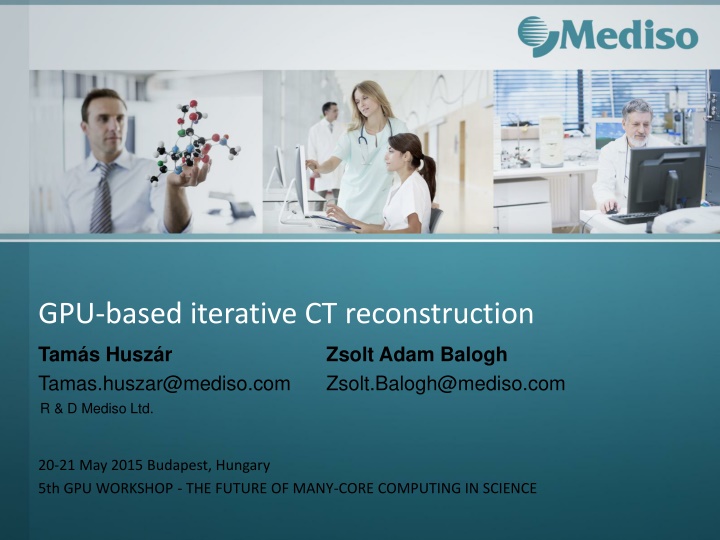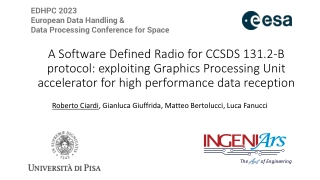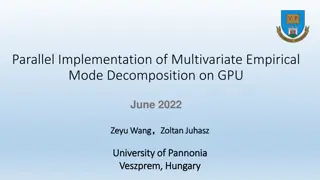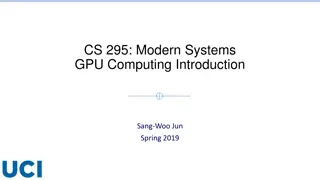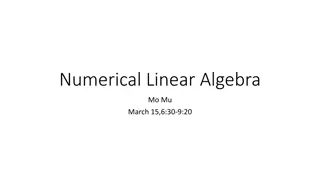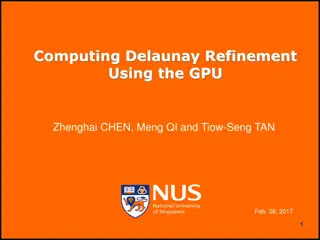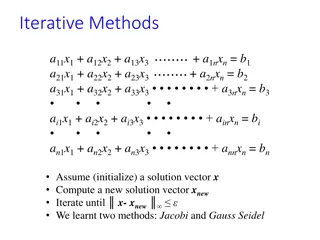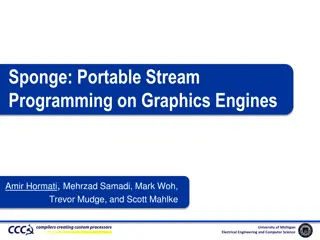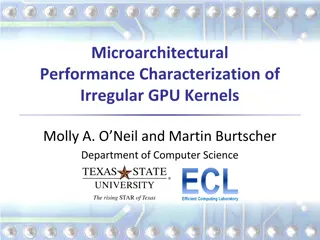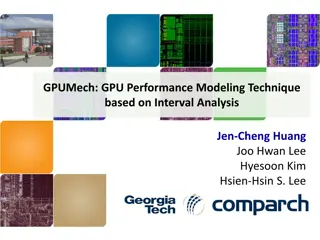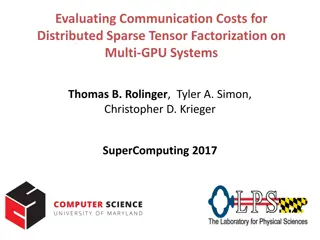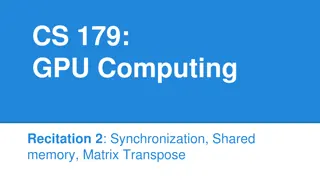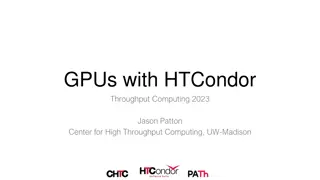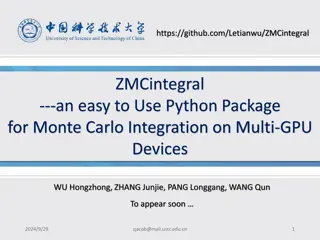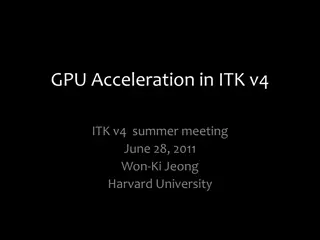GPU-based iterative CT reconstruction
"Tams Huszr and Zsolt Adam Balogh from Mediso Ltd. presented at the 5th GPU Workshop in Budapest, Hungary, discussing the future of many-core computing in science. The workshop focused on GPU-based iterative CT reconstruction techniques and their impact on medical imaging advancements."
Download Presentation

Please find below an Image/Link to download the presentation.
The content on the website is provided AS IS for your information and personal use only. It may not be sold, licensed, or shared on other websites without obtaining consent from the author.If you encounter any issues during the download, it is possible that the publisher has removed the file from their server.
You are allowed to download the files provided on this website for personal or commercial use, subject to the condition that they are used lawfully. All files are the property of their respective owners.
The content on the website is provided AS IS for your information and personal use only. It may not be sold, licensed, or shared on other websites without obtaining consent from the author.
E N D
Presentation Transcript
GPU-based iterative CT reconstruction Tam s Husz r Tamas.huszar@mediso.com R & D Mediso Ltd. Zsolt Adam Balogh Zsolt.Balogh@mediso.com 20-21 May 2015 Budapest, Hungary 5th GPU WORKSHOP - THE FUTURE OF MANY-CORE COMPUTING IN SCIENCE
CUDA CUDA (Compute Unified Device Architecture) A parallel computing platform and programming model invented by NVIDIA. It enables increases in computing performance by exploiting the power of the graphics processing unit (GPU). Hardware Kepler microarchitecture GeForce GTX TITAN Z GeForce GTX TITAN Black (compute capacity 3.5, memory 12 Gb, CUDA cores 5760) (compute capacity 3.5, memory 6 GB, CUDA cores 2688) Maxwell microarchitecture GeForce GTX 980 GeForce GTX TITAN X (compute capacity 5.2, memory 12 GB, CUDA cores 3072) (compute capacity 5.2, memory 4 GB, CUDA cores 2048) 3
CUDA CUDA framework Wraps and hides CUDA functionality Enables fast development Features Smart Device selection Occupancy calculations Kernel launch Memory management 4
CUDA CUDA framework Smart device selection GPU filters (available memory, display cards, ) Get connected displays with NvAPI Occupancy calculations and kernel launch Calculate block size for highest occupancy Semi-automatic with CUDA 6.5 occupancy API Kernel launch macros to hide thread micromanagement 5
CUDA CUDA framework Kernel configuration macros Use cudaFuncGetAttributes to find register and shared memory usage cudaOccupancyMaxPotentialBlockSize kernel info + data size blockSize3D, gridSize3D Kernel launch macros Sync / Async mode for debug Profiling / logging Thread index calculator for the CUDA kernel program Easy indexing for 2D and 3D image arrays using block and grid configuration Kernels must avoid over-indexing 6
CUDA CUDA framework / Example Kernel launch: ADD_CONF(myKernel, 512*512*256); KERNEL_LAUNCH_ASYNC( myKernel, config["myKernel"], dataSize, parameters, ...); myKernel: uint tid = index(); uint2 pos = getXY( tid, dataSize.width ); data[pos.x, pos.y] = ...; 7
CUDA CUDA framework / Device memory allocation Generalized datastructures for different types array, layered array, global memory, pitched memory 1D, 2D, 3D float, double, Transparent multi-GPU support Examples: template<typename T> DeviceMemoryArray2D<T> template<typename T> DeviceMemoryLinear3D<T> template<typename T> DeviceMemoryLayered3D<T> 8
CUDA Dynamic memory allocation example DeviceMemoryLinear3D<float> volume1(gpu1); DeviceMemoryArray3D<float> volume2(gpu2); volume2.copy(volume1); instead of cudaMemcpy3DParms parms; memset(&parms, 0, sizeof(cudaMemcpy3DParms)); parms.srcPos = srcPos; parms.dstPos = dstPos; parms.srcPtr = make_cudaPitchedPtr(devPtr, pitch, x, y); parms.dstArray = array; parms.extent = extent; parms.kind = cudaMemcpyDeviceToDevice; cudaMemcpy3DAsync( &parms, 0 ); 9
Iterative CT reconstruction Iterative CT generations 1st generation Filtered Back Projection 2nd generation Image-space Iterative Reconstruction 3rd generation Statistical Iterative Reconstruction 4th generation Model-based Reconstruction 10
Iterative CT reconstruction Forward- projection Start image Iterated image Iterated projections FBP Projections Result Back- projection 11
Iterative CT reconstruction Iterative reconstruction types Algebraic reconstruction techniques (ART, SART, SIRT) solving y=Ax, where y is sinogram data, A is system model Statistical reconstruction methods (EM, ML) (I ~ Poisson + Normal) Model-based methods (go beyond modeling statistics of the detected photons as Poisson distributed) 12
Iterative CT reconstruction Maximalization of the conditional probability P( | y ), where is the distribution of linear attenuation coefficients y is the vector of transmission measurements. Backprojection is the value of pixel j, is the measured sinogram along line i, is the intersection length of projection line i with pixel j. 13
Iterative CT reconstruction Reconstructed volume (FBP and iterative) 14
Iterative CT reconstruction Advantages image noise reduction dose reduction artifact reduction Disadvantages computation time (using GPU) model complexity software complexity, non-linear algorithms 15
Iterative CT reconstruction Projector types (parallelization) pixel-driven (ray-driven) voxel-driven distance-driven 16
Iterative CT reconstruction Optimizations CPU vs. GPU Memory access patterns Coalesced access Texture memory vs. global memory Use float instead of double where possible Memory size Multi-GPU 17
Measurements Reconstruction speed GPU vs. CPU 140 130.35487 120 100 80 Time (sec) 60 40 20 2.552949188 0 GPU CPU 18
Measurements Reconstruction speed Global memory vs. Texture memory 2.6 2.552949188 2.55 2.5 2.45 Time (sec) 2.4 2.34087957 2.35 2.3 2.25 2.2 global memory texture memory 19
Measurements Reconstruction speed Float vs. double 10 8.6125 9 8.0058 8 7 6 Time (sec) 5 4 3 2.5529 2.3621 2 1 0 float double Titan Black Titan X 20
Measurements Reconstruction speed GPU memory usage test 160 140 134.033125 133.38175 120 100 Time (sec / 1 Gb) 82.6715 80 60 40 20 0 Titan Black (6 Gb) Titan X (12 Gb) GTX 980 (4 Gb) 21
Measurements Titan X speedup Relative reconsturction time compared to Titan X 3.5 2.957106591 3 2.5 2 1.709642155 1.507148594 1.469554695 1.5 1.225485182 1 0.945057807 1 0.5 0 Titan X GTX 980 Titan Z (1 GPU) Titan Z (2GPU) Titan Black GTX 690 (1GPU) GTX 690 (2GPU) 22
Thank you for your attention! www.mediso.com 23
